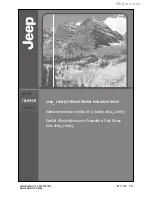
GE Multilin
T60 Transformer Protection System
5-317
5 SETTINGS
5.8 INPUTS AND OUTPUTS
5
OUTPUT H1a OPERATE:
“
VO1
”
OUTPUT H1a RESET:
“
VO2
”
5.8.4 VIRTUAL OUTPUTS
PATH: SETTINGS
INPUTS/OUTPUTS
VIRTUAL OUTPUTS
VIRTUAL OUTPUT 1(96)
There are 96 virtual outputs that may be assigned via FlexLogic. If not assigned, the output will be forced to ‘OFF’ (Logic 0).
An ID may be assigned to each virtual output. Virtual outputs are resolved in each pass through the evaluation of the Flex-
Logic equations. Any change of state of a virtual output can be logged as an event if programmed to do so.
For example, if Virtual Output 1 is the trip signal from FlexLogic and the trip relay is used to signal events, the settings
would be programmed as follows:
VIRTUAL OUTPUT 1 ID:
"Trip"
VIRTUAL OUTPUT 1 EVENTS:
"Disabled"
5.8.5 REMOTE DEVICES
a) REMOTE INPUTS/OUTPUTS OVERVIEW
Remote inputs and outputs provide a means of exchanging digital state information between Ethernet-networked devices.
The IEC 61850 GSSE (Generic Substation State Event) and GOOSE (Generic Object Oriented Substation Event) stan-
dards are used.
The sharing of digital point state information between GSSE/GOOSE equipped relays is essentially an extension to Flex-
Logic, allowing distributed FlexLogic by making operands available to/from devices on a common communications net-
work. In addition to digital point states, GSSE/GOOSE messages identify the originator of the message and provide other
information required by the communication specification. All devices listen to network messages and capture data only from
messages that have originated in selected devices.
IEC 61850 GSSE messages are compatible with UCA GOOSE messages and contain a fixed set of digital points. IEC
61850 GOOSE messages can, in general, contain any configurable data items. When used by the remote input/output fea-
ture, IEC 61850 GOOSE messages contain the same data as GSSE messages.
Both GSSE and GOOSE messages are designed to be short, reliable, and high priority. GOOSE messages have additional
advantages over GSSE messages due to their support of VLAN (virtual LAN) and Ethernet priority tagging functionality.
The GSSE message structure contains space for 128 bit pairs representing digital point state information. The IEC 61850
specification provides 32 “DNA” bit pairs that represent the state of two pre-defined events and 30 user-defined events. All
remaining bit pairs are “UserSt” bit pairs, which are status bits representing user-definable events. The T60 implementation
provides 32 of the 96 available UserSt bit pairs.
The IEC 61850 specification includes features that are used to cope with the loss of communication between transmitting
and receiving devices. Each transmitting device will send a GSSE/GOOSE message upon a successful power-up, when
the state of any included point changes, or after a specified interval (the
default update
time) if a change-of-state has not
occurred. The transmitting device also sends a ‘hold time’ which is set greater than four times the programmed default time
required by the receiving device.
Receiving devices are constantly monitoring the communications network for messages they require, as recognized by the
identification of the originating device carried in the message. Messages received from remote devices include the mes-
sage
time allowed to live
. The receiving relay sets a timer assigned to the originating device to this time interval, and if it
has not received another message from this device at time-out, the remote device is declared to be non-communicating, so
it will use the programmed default state for all points from that specific remote device. If a message is received from a
remote device before the
time allowed to live
expires, all points for that device are updated to the states contained in the
message and the hold timer is restarted. The status of a remote device, where “Offline” indicates non-communicating, can
be displayed.
The remote input/output facility provides for 32 remote inputs and 64 remote outputs.
VIRTUAL OUTPUT 1
VIRTUAL OUTPUT 1 ID
Virt Op 1
Range: Up to 12 alphanumeric characters
MESSAGE
VIRTUAL OUTPUT 1
EVENTS: Disabled
Range: Disabled, Enabled
Содержание T60
Страница 6: ...vi T60 Transformer Protection System GE Multilin TABLE OF CONTENTS ...
Страница 14: ...xiv T60 Transformer Protection System GE Multilin TABLE OF CONTENTS ...
Страница 34: ...1 20 T60 Transformer Protection System GE Multilin 1 5 USING THE RELAY 1 GETTING STARTED 1 ...
Страница 118: ...3 48 T60 Transformer Protection System GE Multilin 3 3 DIRECT INPUT OUTPUT COMMUNICATIONS 3 HARDWARE 3 ...
Страница 146: ...4 28 T60 Transformer Protection System GE Multilin 4 3 FACEPLATE INTERFACE 4 HUMAN INTERFACES 4 ...
Страница 490: ...5 344 T60 Transformer Protection System GE Multilin 5 10 TESTING 5 SETTINGS 5 ...
Страница 522: ...6 32 T60 Transformer Protection System GE Multilin 6 5 PRODUCT INFORMATION 6 ACTUAL VALUES 6 ...
Страница 536: ...7 14 T60 Transformer Protection System GE Multilin 7 1 COMMANDS 7 COMMANDS AND TARGETS 7 ...
Страница 538: ...8 2 T60 Transformer Protection System GE Multilin 8 1 DIRECTIONAL PRINCIPLE 8 THEORY OF OPERATION 8 ...
Страница 568: ...10 12 T60 Transformer Protection System GE Multilin 10 6 DISPOSAL 10 MAINTENANCE 10 ...
Страница 596: ...A 28 T60 Transformer Protection System GE Multilin A 1 PARAMETER LISTS APPENDIX A A ...
Страница 716: ...B 120 T60 Transformer Protection System GE Multilin B 4 MEMORY MAPPING APPENDIX B B ...
Страница 762: ...E 10 T60 Transformer Protection System GE Multilin E 1 IEC 60870 5 104 PROTOCOL APPENDIX E E ...
Страница 774: ...F 12 T60 Transformer Protection System GE Multilin F 2 DNP POINT LISTS APPENDIX F F ...
Страница 785: ...GE Multilin T60 Transformer Protection System H 9 APPENDIX H H 2 ABBREVIATIONS H Z Impedance Zone ...
















































